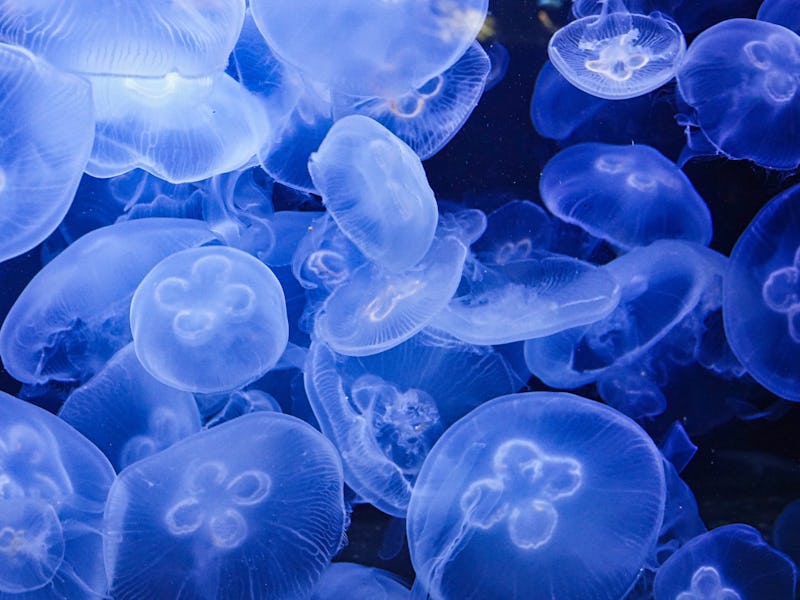An uptick in jellyfish sightings is an eerie herald of climate change to come
Increasingly abundant jellyfish are just one example of the many ways that plankton are reflecting climate change’s influence on the ocean.

Did you see a jellyfish on a recent trip to the seaside? U.K. beachgoers are more likely to spot one now than in the past, as rising sea temperatures due to climate change have ushered more of these gelatinous animals into the waters around northern Europe.
Jellyfish don’t swim like fish. They belong to the plankton: a diverse group of marine creatures that drift through the sea, floating wherever the currents take them. Jellyfish are among the few types of plankton visible to the human eye. Most plankton is tiny (smaller than two millimeters) and can only be seen with a microscope.
Although largely invisible, plankton is the base of the ocean food web, eaten by fish, seabirds, and even whales. Species that don’t eat plankton, like seals, will eat organisms that do. Globally, phytoplankton (single-celled algae which, like trees and shrubs on land, are mostly green in color and use chlorophyll to photosynthesize) produce half of the oxygen we breathe.
Increasingly abundant jellyfish is just one example of the many ways that plankton is reflecting climate change’s influence on the ocean. My research team has found that the species making up North Atlantic plankton communities are also shifting as sea temperatures rise.
We analyzed plankton data collected using nets and bottles throughout the northeast Atlantic over the past 80 years. We found that the larvae of crabs, starfish, sea urchins, and lobsters are becoming more common, while shrimp-like crustaceans called copepods (a critical food source for fish, seabirds, and even basking sharks) are declining.
These are big changes among some of the smallest forms of life, and they will affect the entire marine food web, as well as humans. We must understand these changes in order to adapt to them. That could mean new fishing practices — and even diets.
In a jellyfish’s wake
Zooplankton (the animal subset of plankton) consists not only of copepods and jellyfish, but also of the larval stages of fish, crustaceans, and echinoderms (the “spiny skin” group that starfish and sea urchins belong to), which later settle to the sea floor and mature into their familiar adult forms. Both zooplankton and phytoplankton communities are highly diverse, containing species of all sorts of weird and wonderful shapes.
Since the 1960s, colder-water zooplankton species have been retreating toward the Arctic, followed by warmer-water species that are also tracking rising sea temperatures northward. The warmer-water zooplankton species which now dominate northern European waters are generally smaller and less nutritious than the cold-water species they have replaced.
The seasonal timing of when plankton is abundant in the North Sea has also shifted, including around the United Kingdom. While the seasonal cycle of phytoplankton is driven by sunlight and so hasn’t changed, the point in the year when some zooplankton species are most abundant now arrives earlier, as shorter and warmer winters cause the eggs of some species to hatch sooner. This has meant a mismatch between the spring phytoplankton bloom and the annual peak abundance of the zooplankton that gorge on it.
These shifts have meant the quantity and type of food available to larval fish (which are zooplankton themselves but eat smaller zooplankton) is changing in the North Atlantic. Warm-water species such as bluefin tuna and anchovies are now commonly found in northern European waters, while cod, herring, whiting, and sprat, all important commercial fish species, have declined in number.
Fishery managers need to work with scientists to set quotas that ensure these new species are fished sustainably, while coastal fishing communities may have to catch new species as familiar ones decline. The public may have to adapt their diets too as traditional species, such as cod in the United Kingdom, become scarcer.
The jellyfish you now see in U.K. waters might have once been a rarity, but it’s following a (largely invisible) crowd that is upending marine food webs and changing the kind of fish you might buy and eat locally. The next time you watch the hypnotic motion of one of these beautiful creatures as it pulses through the water, think of the changes its arrival portends, both for the ocean and yourself.
This article was originally published on The Conversation by Abigail McQuatters-Gollop at the University of Plymouth. Read the original article here.